Planning your own trip? Prepare for your trip
Use Rough Guides' trusted partners for great rates
Plan and book your private, tailor-made tour with vetted local experts
Viseu sits on a high plateau between the mountains and the Atlantic, and it quietly ranks as one of Portugal’s most livable cities. The Romans named it Viso for its sweeping views, and local legend claims that Viriatus, a warrior leader, fought them off from nearby hills. Today, the city combines a remarkably preserved old quarter with a modern center full of leafy parks, broad avenues, and the vast Palácio do Gelo shopping complex.
Its top attraction is the Museu de Grão Vasco, home to some of the region’s most important religious art. Viseu is also at the heart of Dão wine country, and you will find local reds and whites on every restaurant table. If you visit in late summer, plan around the Feira de São Mateus, a long-running fair that brings music, food, and open-air events to the city from mid-August through September.

Hi, I’m Sara, your Portugal travel expert. If you’re looking for a city that combines medieval charm with a modern pulse, Viseu is the one you probably didn’t know you needed. It’s tucked away between the Serra da Estrela mountains and the coast, and while it flies under most travel radars, it consistently ranks as one of Portugal’s most livable cities. Spend a day here and you’ll see why.
The old town climbs around a stone cathedral like vines on a wall, while just downhill, you’ll find leafy boulevards, sleek cafés, and the sort of easygoing pace that makes you slow down without trying. This Viseu travel guide gives you the essentials: how to get here, where to stay, and what not to miss. No matter if you’re visiting for the food, the history, or just a break from the big cities, Viseu delivers quiet confidence and a strong glass of Dão wine.
Sara’s tip
Visit the Museu de Grão Vasco early in the day when it’s empty and cool inside. Then head straight to the rooftop terrace of the Solar do Vinho do Dão for a glass of red and a view over the tiled rooftops.
Best time to visit
Spring and autumn are ideal, with warm days, cool nights, and fewer people in the old town. April to June brings green hills and vineyard views. September and October are grape harvest season, and local wines are at their freshest. July and August are hotter, with temperatures climbing past 85°F (29°C), but the city stays manageable thanks to its elevation and green spaces. In December, Viseu lights up for Christmas and has one of the best holiday markets in the region.
How to get to Viseu
There’s no train station in Viseu, but it’s well-connected by bus. You can catch direct services from Lisbon, Porto, and Coimbra, most of them run by Rede Expressos. The journey takes about 3 hours from Lisbon or 2 hours from Porto. If you’re driving, Viseu is an easy detour off the A25 motorway, with good road links in all directions. Having your own car helps if you plan to explore nearby vineyards or the Serra da Estrela.
Best areas to stay in Viseu
Viseu is set on a high plateau in central Portugal, roughly halfway between Porto and the Serra da Estrela mountains. It’s around a two-hour drive from Porto and three hours from Lisbon, with good road access and regular bus connections. There’s no train station, which partly explains why the city stays quiet even in peak season.
If you’re looking beyond the obvious and want a city that still feels lived in, Viseu is one of the best places to visit in Portugal. Its historic center has charm without crowds, and its location puts you within easy reach of vineyard estates, mountain drives, and some of the country’s most overlooked countryside. It’s not on every Portugal itinerary, but it should be.


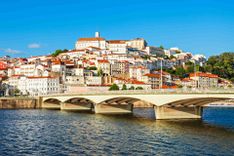
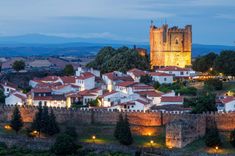

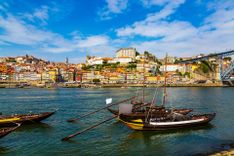










Viseu is a city you can mostly cover on foot, especially if you’re staying near the center. The historic old town is compact, and walking is the best way to take in its winding lanes, tiled façades, and hidden viewpoints. That said, the city isn’t flat, and some streets are steep or uneven, especially around the cathedral. If you’re planning to explore the outskirts, vineyards, or nearby towns, a car makes things easier. Public transport exists but is limited in scope and frequency.
You can see the highlights of Viseu in a single full day. That gives you enough time to wander the old town, step inside the cathedral, browse the Museu de Grão Vasco, and linger in a café on Rossio Square. The compact center makes it easy to explore without rushing.
That said, Viseu is worth at least two days if you want to enjoy its slower rhythm. An overnight stay lets you see the city after day-trippers leave, when the streets quieten and locals reclaim the squares. With more time, you can branch out to the surrounding countryside, visiting Dão vineyards for tastings or exploring the Caramulo mountains just to the west.

Pousada de Viseu © TMP - An Instant of Time/Shutterstock
Viseu has plenty of places to stay, from boutique hotels in the old town to vineyard estates just outside the city. Each area offers a different take on the city, so it’s worth choosing a base that fits how you like to travel.
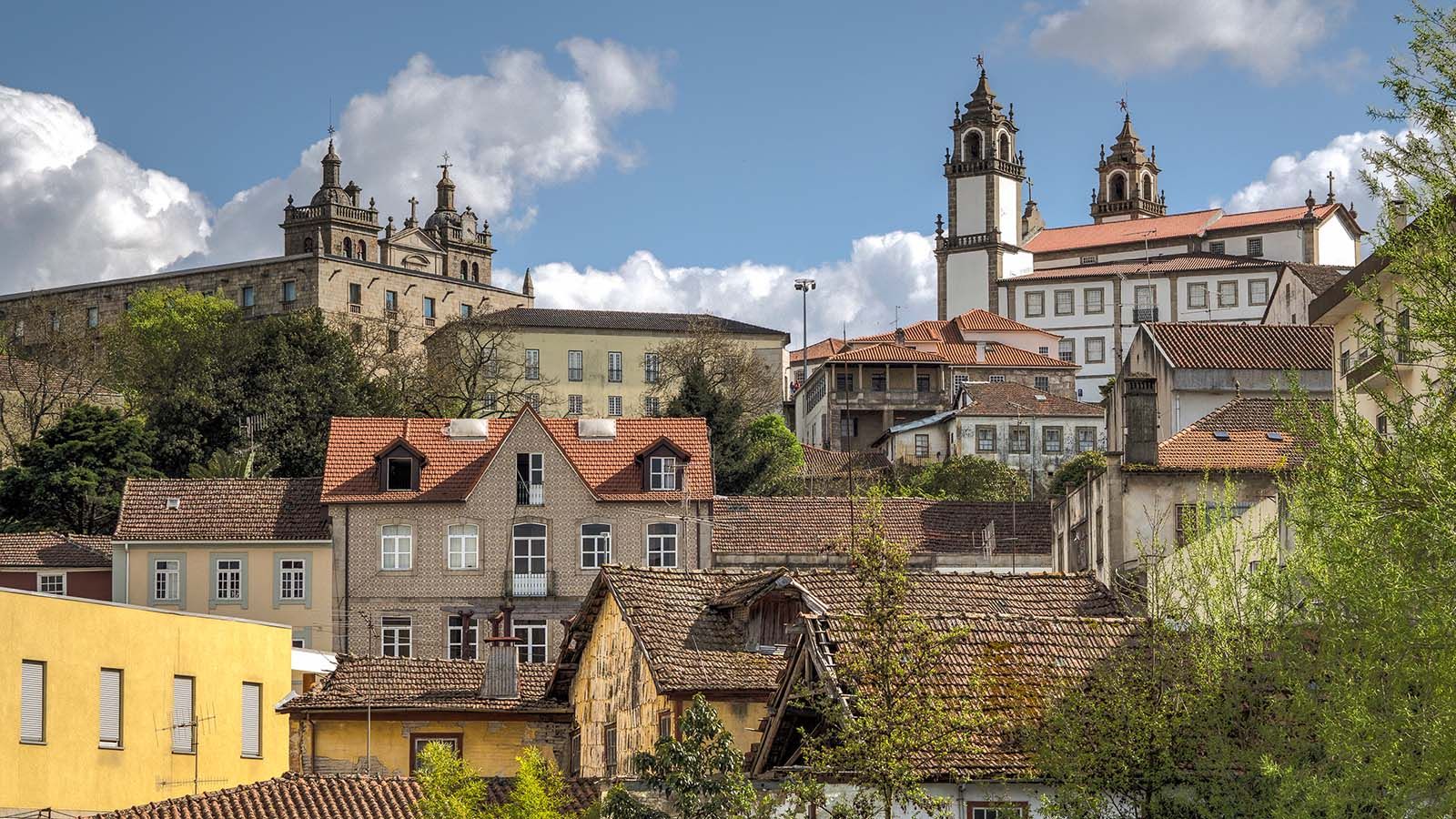
Se in Viseu, Portugal © Shutterstock
Viseu may not shout for attention, but spend a little time here and you’ll find a city full of quiet rewards. Cobbled lanes lead to museums, leafy parks give shade for long afternoons, and the wine flows from surrounding estates. Here’s what to do while you’re here.
The fortress-like Sé sits at the heart of Viseu’s old town, a mix of Romanesque foundations, Gothic arches, and baroque flourishes added over centuries. Step inside and you’ll find a cool, dim interior with ribbed vaulting, gilded altarpieces, and a cloister that links to the Museu de Grão Vasco. Outside, the square is one of the city’s most atmospheric spots, often quiet except for the sound of footsteps on stone.
Visit early in the morning to have it to yourself, or return in the evening when the setting sun lights the granite in soft gold. The climb up through the old town to get here is part of the experience, with narrow lanes and tiled façades revealing themselves as you go.
Housed in the former bishop’s palace beside the cathedral, the Museu de Grão Vasco is one of Portugal’s most underrated museums. Its star attraction is a series of 16th-century panels by Vasco Fernandes, a master of Portuguese Renaissance painting. The detail in his altarpieces is extraordinary, from delicate fabrics to vivid biblical scenes that still feel alive five centuries later. Beyond Fernandes, the museum’s collection includes religious sculpture, Flemish paintings, and a smattering of decorative arts.
The building itself is just as impressive, with high ceilings, wide staircases, and windows overlooking the cathedral square. Take your time here, an hour is enough to see the highlights, but if you enjoy art, you could easily stay longer. A combined ticket with the cathedral cloister makes for a seamless visit.
Parque do Fontelo is Viseu’s green heart, a vast park on the edge of the city where locals come to jog, picnic, and relax. It was once a hunting ground for bishops, and traces of that history remain in old chapels, walls, and fountains scattered among the trees. Today it’s a mix of forested trails, open lawns, and sports fields, with plenty of shade on hot days. Families love it for the playgrounds, while walkers can follow the longer paths into pine woods that feel far from the city.
Bring a picnic or pick up pastries from a bakery in town and find a quiet corner to sit. If you’re here in autumn, the park glows with color, while summer evenings are filled with the sound of crickets. It’s an easy escape when you’ve had enough of cobblestones.
Viseu’s historic core is a warren of cobbled lanes that wind uphill toward the cathedral. Start at Praça Dom Duarte, a lively square named after the Portuguese king who was born here, then drift without a plan. You’ll pass stone houses with wrought-iron balconies, tiled façades in faded blues and greens, and quiet little chapels. Keep an eye out for the traditional pavement mosaics, known as calçada portuguesa, that decorate the streets with geometric patterns.
There are plenty of cafés where you can stop for a bica and watch the world go by. Evenings are particularly atmospheric, when the granite glows under streetlamps and the pace slows. Walking here is not just sightseeing, it’s the way to feel the rhythm of the city.
The Dão is one of Portugal’s oldest wine regions, known for elegant reds and increasingly good whites, and Viseu is its heart. The best place to sample them in the city is the Solar do Vinho do Dão, a wine lodge set in a 17th-century manor house. Inside, you can order tasting flights or individual glasses and get advice from knowledgeable staff. The atmosphere is relaxed rather than formal, with wooden beams, cozy corners, and a rooftop terrace overlooking the city.
It’s a perfect stop before dinner, or a lazy afternoon option when sightseeing feels like too much effort. Even if you’re new to wine, the staff will guide you through the basics and point out bottles worth taking home. Tastings here connect you directly to the vineyards that surround the city.
This small museum is dedicated to Almeida Moreira, an early 20th-century art collector who left his house and collection to the city. It’s less well known than the Museu de Grão Vasco but worth a look if you enjoy eclectic finds. Inside, you’ll find portraits, furniture, ceramics, and a mix of decorative arts. The house itself is part of the charm, with creaking floors, period furnishings, and a slightly faded grandeur. It feels like stepping into another time, and the contrast with Viseu’s modern boulevards outside is striking.
You won’t need more than half an hour, but it’s a quiet, atmospheric stop that adds another layer to the city’s cultural story. Admission is inexpensive, and it rarely gets crowded, making it a rewarding detour.
Rossio Square is the social heart of modern Viseu, framed by leafy gardens and busy cafés. At first glance, it looks like a pleasant but ordinary plaza. Take a closer look at the long tiled panels on the walls of the surrounding buildings. These azulejos depict scenes from Viseu’s history, including the story of Viriatus, the local warrior who resisted the Romans, and moments from the city’s medieval past.
The panels are bold, detailed, and surprisingly modern in style, created in the mid-20th century. They make the square more than just a meeting point, turning it into an open-air gallery of local identity. Grab a coffee at one of the terrace cafés, find a shady table, and take time to study the tiles. They tell the story of Viseu in a way no textbook can.
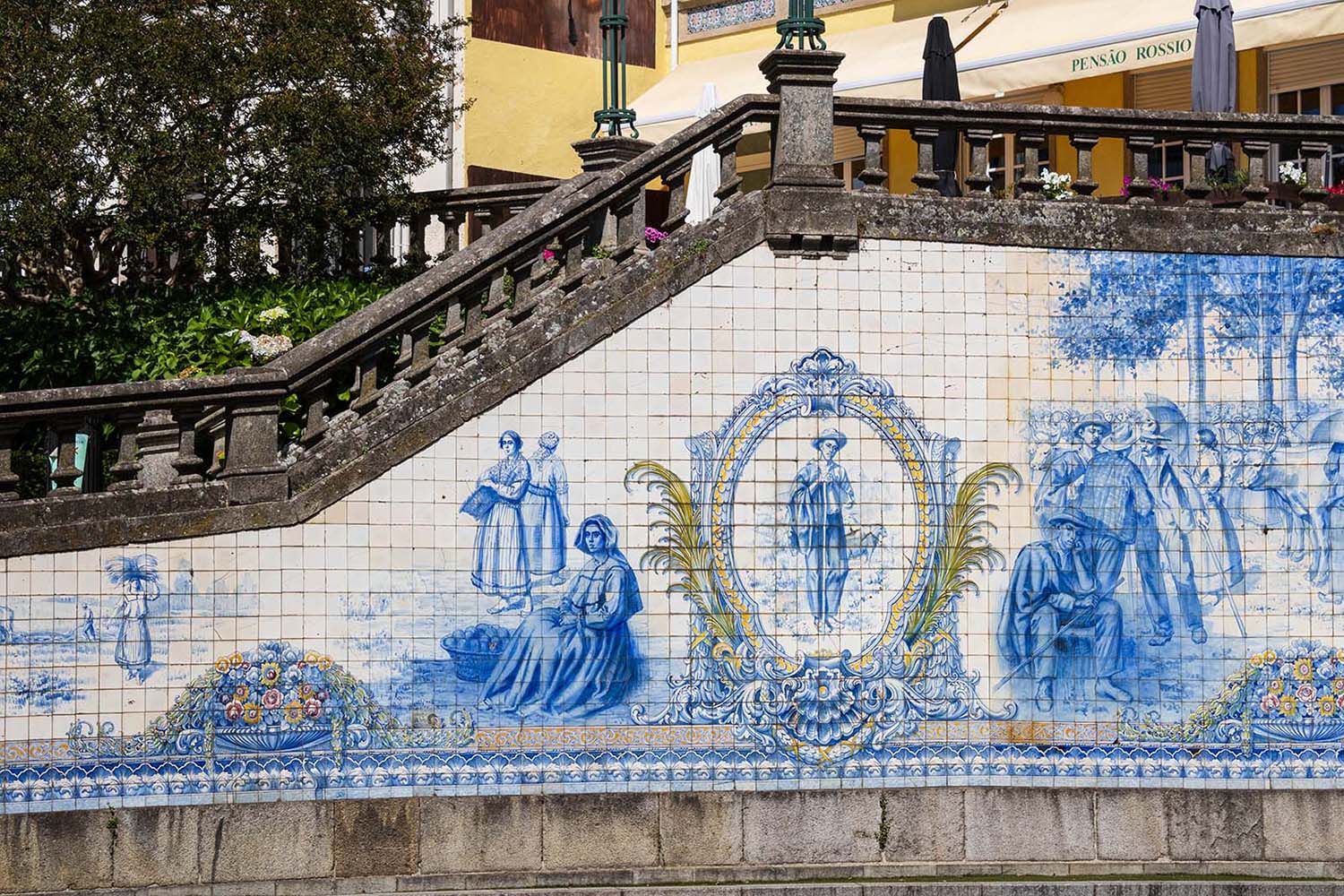
The curious Tile Panel in Praça da República (Rossio) in Viseu © Shutterstock
Palácio do Gelo is not your typical Portuguese shopping mall. Opened in the 1990s and expanded since, it is one of the biggest in the country and doubles as an entertainment hub. You’ll find international chains, local boutiques, and plenty of restaurants, but what makes it stand out is the ice rink and leisure facilities. Families come here for a break from sightseeing, especially on hot days, and kids love the novelty of skating in central Portugal.
Even if malls aren’t usually on your list, it’s worth a look to see how Viseu blends modern life with tradition. From the upper floors, you get surprising views over the city, while the food court is a handy place to try local snacks between shops. It’s a very different Viseu experience from the cathedral square, but just as much part of the city’s identity.
For a taste of the countryside without leaving the city, rent a bike or simply walk part of the Ecopista do Dão. This 49 km greenway follows a former railway line from Viseu to Santa Comba Dão, cutting through vineyards, forests, and small villages. The first stretch begins right in Viseu, making it easy to sample even if you only have a few hours. It’s flat, well-paved, and family-friendly, with old stations converted into cafés and rest stops. In spring, the route is lined with wildflowers, while autumn brings vineyards heavy with grapes.
You don’t need to do the full distance, even a short section offers a different perspective on the region. Bring water, especially in summer, and expect to share the trail with cyclists, walkers, and the occasional farmer heading to the fields.
Every year from mid-August to late September, Viseu hosts the Feira de São Mateus, one of the country’s oldest fairs. It began in the Middle Ages as a religious gathering and has grown into a city-wide festival that mixes concerts, food stalls, agricultural shows, and carnival rides. The fairgrounds on the edge of town fill with locals and visitors alike, and the atmosphere is lively without feeling overwhelming. You can sample regional specialties like roasted chestnuts and bifanas, listen to live music, or browse stalls selling everything from crafts to farm tools. The highlight comes on September 21, Dia de São Mateus, when the celebrations reach their peak.
Viseu has a temperate climate influenced by both the Atlantic and the mountains, which means warm summers, cool winters, and noticeable shifts between day and night. Sitting on a plateau at around 480 meters, it avoids the coastal humidity and the harsher extremes of the Serra da Estrela. Average temperatures range from 46°F (8°C) in January to 82°F (28°C) in August, though heatwaves can send summer highs into the 90s. Winters are cooler, but rarely severe. For current forecasts, check IPMA (Portuguese Institute for Sea and Atmosphere).
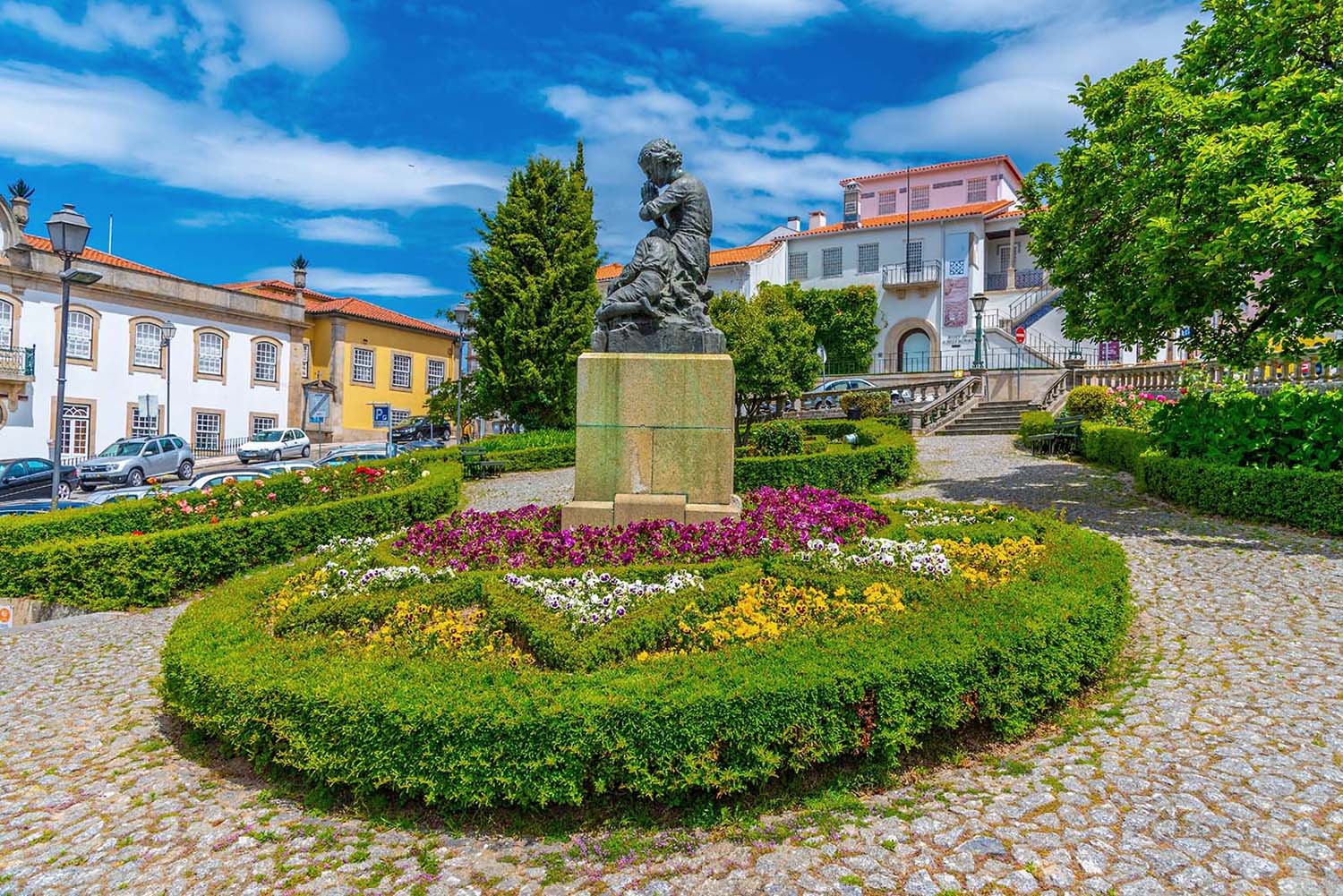
View of the museum of Almeida Moreira in Viseu, Portugal © Shutterstock
Viseu’s dining scene mixes hearty mountain flavors with the elegance of its Dão wine culture. You’ll find rustic taverns serving stews alongside modern restaurants experimenting with regional classics. Expect generous portions, bold reds, and menus that lean heavily on meat, bread, and seasonal produce. Eating here is unpretentious but rewarding, with plenty of variety to keep you satisfied over a couple of days.
Discover Viseu through guided experiences that are private, flexible, and shaped by local experts who know the city and the surrounding Dão wine country inside out.
Discover Portugal's most captivating stories
Use Rough Guides' trusted partners for great rates
written by
Olga Sitnitsa
Online editor at Rough Guides, specialising in travel content. Passionate about creating compelling stories and inspiring others to explore the world.